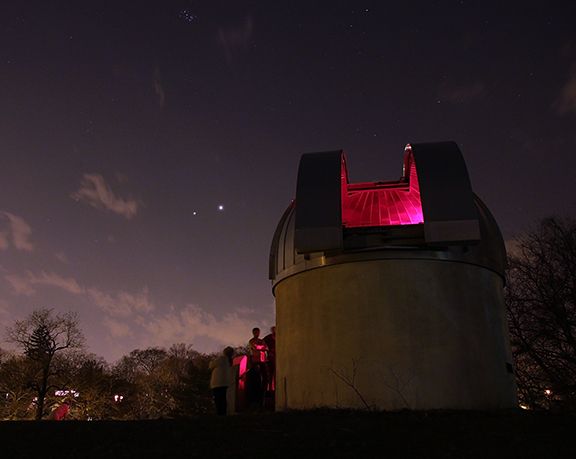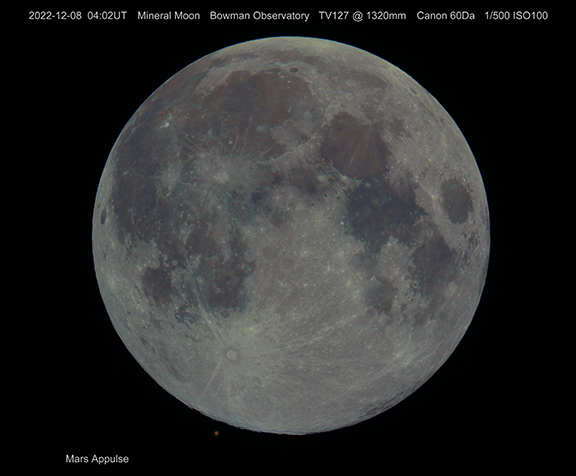 Ever since he was a kid, Rick Bria has been looking to the stars.
Ever since he was a kid, Rick Bria has been looking to the stars.
“Apollo 11 landed on the moon when I was 11, and so everybody in our school wanted to be an astronaut,” he says. “We called it outer space back then, and I was interested in outer space but that of course transferred to astronomy.”
He received his first telescope when he was in sixth grade and started craning it toward the heavens regularly. “Once I saw Saturn, the moon and Jupiter, I was hooked,” he says.
Today, Bria shares that love of astronomy with others as the vice president of The Astronomical Society of Greenwich, Inc., a nonprofit that manages the Bowman Observatory in Greenwich.
The Greenwich Bowman Observatory is one of several spots in Fairfield County and surrounding areas where Connecticut star gazers can get up close views of celestial bodies.
The Astronomical Society of Greenwich hosts two public viewing events per month on the first and second Wednesday of each month from 7 to 9 p.m. this time of year. Elsewhere on the coast, the Westport Astronomical Society hosts weekly star parties on Wednesdays after 8 p.m. at its observatory. Western Connecticut State University also has an observatory, but it has been closed to the public since the pandemic started, although is expected to reopen to the community soon. Just outside of Fairfield County, in New Milford, the John J. McCarthy Observatory hosts an open house on the second Saturday of
each month.
These volunteer-run observatories give seasoned stargazers and new astronomy enthusiasts a chance to use high-powered telescopes and learn more about science in the process. They also help satiate the public’s interest in astronomy, which has lit up in recent years, says John Gebauer a volunteer at the John J. McCarthy Observatory. “With people stranded at home during the pandemic, it seems that many turned to astronomy as a hobby that could be practiced without close contact with others,” he says. “There have [also] been notable space-based events — James Webb Telescope, Mars rovers, Solar eclipses, etc. — that have captured people’s interest in the domain.”
 Additionally, he says, “SpaceX has recreated an excitement and energy to space launches that hasn’t existed since the early days of the Space Shuttle program.”
Additionally, he says, “SpaceX has recreated an excitement and energy to space launches that hasn’t existed since the early days of the Space Shuttle program.”
This time of year, there is plenty for astronomy enthusiasts to see. “Saturn, the crown jewel of the solar system, will be visible in the evening sky throughout the remainder of the year,” says Bill Cloutier, a volunteer at the John J. McCarthy Observatory. Neptune, Jupiter, and Uranus should also be visible, as will the Leonid meteor shower, which will peak around November 18. Cloutier adds, “Late fall is an opportune time to see the Andromeda Galaxy, the closest, largest galaxy in our galactic neighborhood.”
Observatory visitors over the next two months should be able to spy some spectacular details.
“You’ll see Saturn’s rings, you’ll see probably about four to six of its moons,” Bria says. He adds, depending on where Jupiter is in its orbit, viewers often get a chance to see the planet’s famous red spot.
With all the talk of UAPs (the updated term for UFOs) and space junk in recent times, some telescope viewers will be happy to know that they can see more than planets, stars, and moons. At the McCarthy Observatory volunteers are always on the lookout for bright passes of the International Space Station and there will be several good opportunities to see the station in November, says Roger Moore, a volunteer at the John J. McCarthy Observatory. (Home stargazers can consult the website heavens-above.com if they are looking to spot the station on their own.)
Just don’t expect any flying saucers or little green men. “I’ve looked at the night sky more than the next 10 people you know, and I’ve never seen anything I couldn’t explain,” Bria says. “I’ve seen a lot of strange stuff in the sky, but it all belongs up there.”
As for those just getting into astronomy, attending an event at an observatory is a great way to learn the basics and meet others with a shared interest. You can also start learning more about stars with the naked eye. For a starter telescope, Bria recommends the Orion SkyQuest XT6 Classic Dobsonian Telescope Kit and Dobsonian telescopes in general. “They’re a very simple telescope to operate, yet they have the potential to see anything in the sky,” he says. Another option is a good pair of binoculars. “With a decent pair of binoculars, you can get a fantastic view of the moon,” he says. “You can see star clusters, nebula, and even the moons of Jupiter with a good pair of binoculars.”
Viewing the stars can also give one a sense of the history of science. “It’s basically looking around the sky and kind of seeing things as they were seen by the first astronomers,” Bria says.